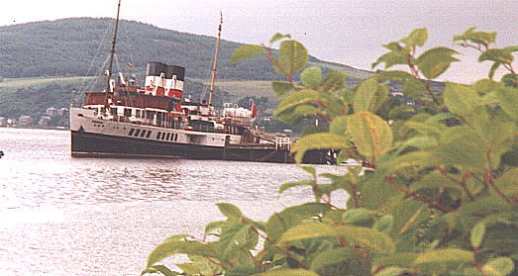 |
Waverley’s ‘Summer’
 |
a first report on the 1999 Clyde season
words and pictures by Stuart Cameron
Since Waverley returned to the Clyde 10 days ago the weather can best be described as indifferent. During the last weekend of June, both Waverley Excursion’s vessels were sailing in Central Scotland - Waverley at home on the Clyde and Balmoral in the East on the Forth.
On Saturday 26th June Waverley arrived back at her base at Glasgow Anderston Quay at 0500 after her 7 week Bristol Channel (and Poole) season. She had the rest of the day off to get ready for her main Clyde summer season.
Meanwhile BALMORAL was sailing out of a new Forth Port - Leith - her previous berth at Granton Harbour being unavailable due to harbour redevelopment. Her berth at Leith was immediately ahead of that of the former
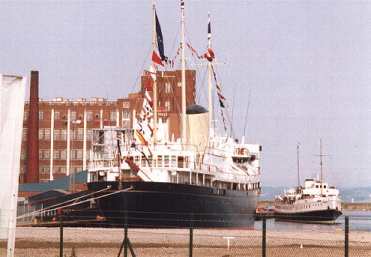 |
Royal Yacht Britannia which is berthed in Leith Docks as a tourist attraction. Her Saturday sailing took her across to Burntisland, after which she had over 300 aboard, but her next call - at Anstruther - had to be abandoned after the harbour master advised Capt. Graeme Gellatly that the swell in the harbour made an attempt inadvisable. Balmoral cruised towards the Isle of May (but not round it) after which she headed for the Bass Rock. However, a heavy swell on the beam made conditions uncomfortable for passengers and Capt Gellatly decided to head up firth for more shelter.
None of the passengers were too upset about the change of roster, realising that Graeme had made great efforts to make their day as enjoyable as possible in the conditions.
The following day Waverley resumed her Clyde programme with Capt Steve Colledge in command and the Welsh flag at her bow. This was a traditional Sunday cruise to Loch Long and Loch Goil and the weather turned out to be much better than forecast. Unfortunately the sail into Loch Goil had to be abandoned due to naval operations. These lochs form an exercise area for vessels from the nearby Coulport and Faslane bases and are under the control of the Queen’s Harbourmaster. Like all other vessels Waverley has to have permission to sail in the lochs and on this occasion Loch Goil was excluded.
On Monday 28th June (planned as an off service day) Waverley performed an extra sailing with a late end of term Glasgow school charter. The school had extra places aboard and invited a group of Kosovar refugee children and their parents (currently living in Glasgow) to join them for a traditional trip ‘Doon the Watter’. The guests seemed impressed.
Waverley’s second Clyde weekend did not enjoy good weather but passenger numbers were boosted by the Glasgow International Jazz Festival charter on Friday and special parties from Tunnock’s (of Caramel Wafer fame!) and Brightwater Holidays on Saturday. The St Andrew’s Saltaire of Scotland at the ship’s bow marked the return of Capt Steve Mishel for a period of relief duty aboard Waverley although Wales was still represented in the form of Captain Ted Davies, sailing as Chief Officer. It was good to see the old ‘Balmoral duo’ in combination again and the Waverley enthusiasts have cause to be grateful to both gentlemen for their continued vital contribution to her programme. On Saturday, Derek Peters returned to the Purser’s office to enable Jim McFadzean a day off for commitments elsewhere. I remembered a day 17 years earlier (May 1982, I think) when Derek was the Purser on Waverley. As we steamed out of Scarborough with about 600 Tynesiders and Yorkshiremen aboard, Derek bravely announced that he was pleased to inform them that Scotland had just beaten England (5-1 I think) at Wembley. The silence was awesome. Funny how you remember these things!
On her way down the Clyde Waverley passed the closure threatened Kvaerner Govan shipyard, the last large merchant shipyard on the river that once built over 30% of the world’s tonnage. In its heyday as the Fairfield Shipbuilding & Engineering Company it had built many fine ships from aircraft carriers and battleships to fine liners (particularly the Canadian Pacific Empresses) and paddle steamers - including the famous Jeanie Deans and the ‘ultimate’ Cardiff Queen. Now the last hull is on the ways and the future is not bright for the 1200 shipbuilders at the yard. It was founded in the 1860s by an engineering genius John Elder who invented the Compound expansion engine and was well on his way to developing the triple expansion engine when he died at an early age. His shipyard has survived him by 130 years but, sadly, it may not last long enough to see in the 21st Century.
Across the river Waverley’s passengers could see the massive bulk of Meadowside Granary, the largest brick building in Europe. Within a short time it too will be a memory as it disappears to make way for a £500m commercial development by Clydeport along a 2 mile stretch of the North Bank of the Clyde. It will transform the former Anchor Line base at Yorkhill, the Inglis and Henderson shipyards and Meadowside into a large leisure and commercial complex along the lines of San Francisco’s Fishermans Wharf (with concessions for the Scottish weather!) by 2004.
Further down river Waverley passed another multi million pound Clydeside development at Braehead. This massive shopping / leisure complex is to incorporate a maritime heritage centre called Clydebuilt which will feature a special section on Waverley. A small pontoon quay is associated with the centre and last week the 127
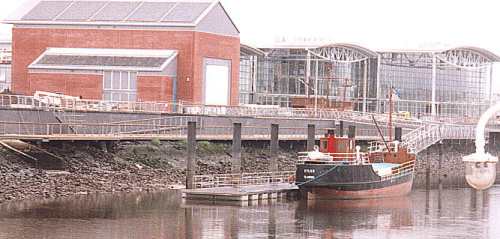 |
year old coaster Kyles, recently part of the Scottish Maritime Museum at Irvine, took up new residence at the pontoon, providing added interest for Waverley’s passengers. Kyles is the oldest Clydebuilt (or rather Cartbuilt) vessel afloat having been built by John Fullerton & Company at the Merkside shipyard in Paisley. The centre is due to open in September.
Further down river Waverley passed the thriving little Ferguson shipyard at Port Glasgow which is currently building an anchor handling tug for Stirling Offshore, the new Uig-Tarbert-Lochmaddy ferry for CalMac (a sister of the Appledore-built Clansman) and a lighthouse tender to replace the Northern Lighthouse Board’s classic tender Fingal. Passing the Garvel Drydock, where Waverley had been in April for significant hull renewal work, passengers could see the impressive masts and rigging of the 1896 sailing vessel Glenlee, now nearing the end of
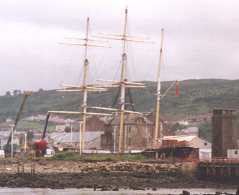 |
a £2m HLF funded restoration. She is one of the last Clyde built ‘tall ships’ afloat (others being the Cutty Sark at Grenwich, Pommern in Holland, the Balclutha at San Francisco Maritime Museum and Falls of Clyde in Honolulu) and is being painted at Garvel prior to joining 80 other Tall Ships at Greenock at the end of this month. After that Glenlee will return to Yorkhill Quay in Glasgow where she will open to the public on August 20th as a permanent feature marketed as ‘the Tall Ship at Glasgow Harbour’ - the latter part of that term being the name of the new Yorkhill / Meadowside development referred to earlier.
Later Waverley passed through the world famous Kyles of Bute and, with a perfect tide and no yachts in the way,
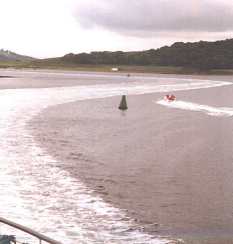 |
Capt Mishel weaved her through the twisting ‘Dog-leg’ channel between Bute and the Burnt Islands rather than take the main channel through the Burnt Islands - another old Clyde tradition preserved as the 20th Century draws to a close.
So who says that a sail doon the watter doesn’t have any interest?